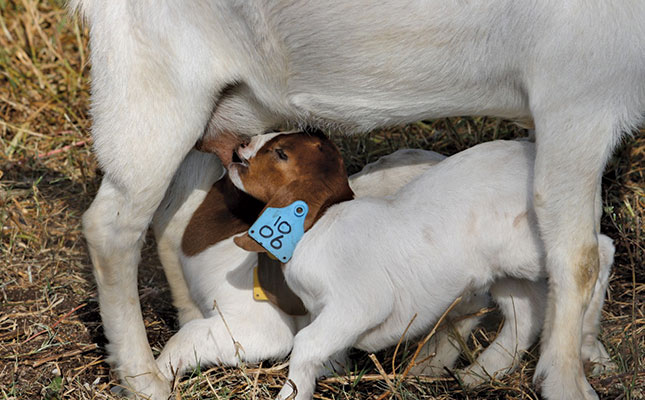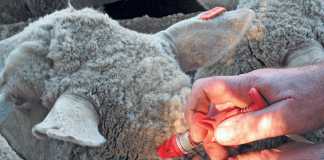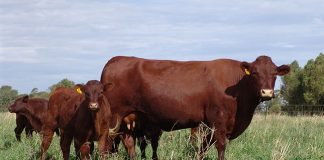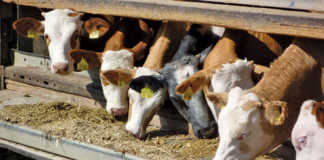
Commercial production uses mainly mass mating, while stud breeders use artificial insemination or single mating. To keep things simple and practical, this article only discusses commercial production.
Start planning the production cycle by deciding on the sale date and then working backwards from there. The various steps in the production cycle include preparation for breeding, teasing does, breeding, kidding, weaning and rounding off sale animals before selling them.
Before mating, rams and ewes should be in good condition as this lays the foundation for a good return on investment. Does in good condition will ensure a good conception rate.
The Condition Scoring Index is a scale of 1 to 5, with 1 being very thin (emaciated) and 5 being very fat (obese). Establish the condition of a goat by placing your hand over its spine just behind the rib cage to find out how thin (or fat) the animal is.
A doe in Condition 1 or 5 will most likely not fall pregnant. Condition 3 is ideal – full muscle, with some fat covering the bones.
A doe can be put to the ram between nine and 12 months, or at 60% of its adult weight. Breeding a young doe affects her growth and can lead to loss in production.
Good grazing positively influences the kidding percentage and milk production and yields a high weaning rate.
Health
Provide a protein lick in the form of a concentrate or lick blocks to the doe four weeks before kidding. Correct supplementation results in heavier kids at birth, improves udder development and increased milk production.
It also assists in getting the doe back on her feet sooner after kidding, allowing the kid to drink earlier. This increases its chance of survival and reduces the chance of a retained afterbirth.
Do all the prescribed inoculations, deworming and dipping on schedule. Inoculate all goats against bluetongue three months before the breeding season and inoculate does against enzootic abortion at least eight weeks before mating.
A multi-vitamin injection at this time is also good practice. A clostridial inoculation six weeks prior to kidding will provide inherited immunity to kids of inoculated animals.
Flush feed breeding animals six to eight weeks before mating; it increases sperm quality and quantity in rams and egg cell production in ewes.
Three months before mating, give vitamin A, D and E as well as zinc supplements to all breeding animals and immunise them against pulpy kidney. Bucks should be fit and free from hoof problems before the mating season.
Teasing – placing the does correctly
For a short kidding season, a short breeding season is essential. Bring all does into heat at more or less the same time by placing bucks in an adjoining pen seven to 10 days before mating.
A doe is in heat when she does not move away when a buck approaches her. She will rub against the fence where the buck is standing or they will try mounting one another.
How to ensure successful mating
Observe a buck when placed with does to make sure it displays good libido. The mating season should be 36 days long and a doe will come on heat twice during this period.
Use one buck for every 30 ewes. Mate young does separately from older does, and do not place a very large buck with a small
Use one buck for every 30 ewes. Mate young does separately from older does, and do not place a very large buck with a small doe on its first mating. Mark does that have been mated with a temporary marker and note the date of mating in your record book.
Mark does that have been mated with a temporary marker and note the date of mating in your record book.
Maintain the doe’s condition after mating by proper nutrition to prevent abortion. Scanning does for pregnancy 40 days after mating is a good idea.
Place a non-pregnant doe with a buck for a second chance. If she does not conceive – and you have done everything possible to ensure conception – cull the doe as she will negatively affect profitability.
Do not stress does during the last four to six weeks of pregnancy, as they can abort. All treatment should have been completed at this stage and you should avoid transporting pregnant animals.
Getting ready for Kidding, and thereafter
Prepare for the arrival of a large number of kids well before the time. Shelter is important during the kidding season and nutritious feed or grazing should be supplied.
Around five to seven days before kidding, put pregnant does into smaller grazing camps nearer to the homestead to limit losses from predation.
When a doe has kidded, place her in a kidding pen for three to five days to bond with her kid and start feeding it quickly. The kid should ingest colostrum within an hour after birth to ensure survival and growth.
If a doe kids with difficulty, the kid is yellow and weighs less than around 3,5kg, her milk production is low, her kid mortality is high and her colostrum is thick and sticky, the doe has a through-flow protein problem.
After they have bonded for three to five days in a kidding pen, move the doe and kid to a small camp. Wean male kids from three months onwards and female kids from between three and four months. Weaning is essential as the doe must regain condition in preparation for the next cycle.
Contact Johan Steyn by visiting www.boergoats.co.za.












